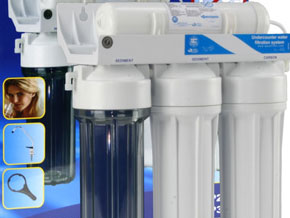Drinking Water Filtration System
It is now necessary for water to be filtered before it becomes potable—one of the benefits of the industrial age. Fortunately, science has progressed far enough to make a drinking water filtration system possible and applicable. Three main methods of filtration have been developed to produce water fit for human consumption, and the only difference is the method they use, and not the product.
There are three basic types of filtration. The first is by physical means, by adding a physical barrier that prevents contaminants to pass through, thereby leaving purer water than before. The second type of filtration is by chemical means, by allowing a chemical process to take place and leaving a byproduct of cleaner water. The third process is through biological processes that remove the contaminants from the water.
Physical Filtration
A good example of this method can be illustrated with the use of a regular coffee maker. By adding filter paper, water passes through the paper with enough coffee relatively unimpeded, but leaving the larger coffee granules behind. Reduce the size to a molecular level with holes the size of water molecules, and only water molecules and other molecules of lesser size can pass through. With physical filtration at a molecular level, even sewage water can be turned into pure water. It turns any water supply into almost an eternal water supply, if there is no loss in the system. But even at a loss, the characteristic of water being reusable as many times as possible shines through.
Chemical Filtration
A common chemical filtration process is the chlorination of water. By adding chlorine, the water is effectively cleared of a majority of viruses, bacteria, amoeba and other possible carriers of waterborne diseases. When chemical filtration was first used to chemically purify water, there were misgivings especially on the effect that chlorine could have on the human body. However, the World Health Organization (WHO) has determined that risks with regard to the use of chlorine as a water purification method is far less than drinking unfiltered water in the first place.
Other water purifying treatment systems that use chemical processes are ozonation (which has been in use in Europe since 1906 although not yet FDA approved in the US), the addition of fluoride (which helps prevent tooth decay), and the use of ultraviolet disinfection.
Biological Filtration
Biological filtration is often used as part of a drinking water filtration system, and not as a complete process in itself. It is often used in the initial stages of water purification and not in the final stages, as contaminants will still be present after biological filtration.
Filtration in Combination
Often, no single filtration system is dependable enough to purify water to a state fit for human consumption. In fact, by having several systems cooperate with each other before water becomes potable, the drawback of one system can be overcome with the efficiency of another. Aside from this type of support, there is also further assurance in redundancy—water filtration for human consumption is vitally important, after all.

